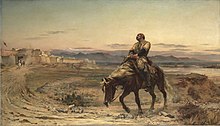William Brydon

William Brydon CB ( October 10, 1811 - March 20, 1873 ) was an assistant doctor in the British Army of the East India Company in the First Anglo-Afghan War . He became known as allegedly the only survivor of an army of 4,500 men who was able to get to safety at the end of the long retreat from Kabul to Jalalabad . Born in London, he was of Scottish descent. He studied medicine at University College London and the University of Edinburgh .
The massacre
The British Army began its withdrawal from Kabul on January 6, 1842, after the two British officials there were murdered. The nearest British garrison was in Jalalabad, 90 miles (140 km) away, and the army had to negotiate snow-covered passes in January. Under the command of Major General William George Keith Elphinstone , a train of 4,500 soldiers and 12,000 civilian employees, including women and children, set out for Jalalabad. They assumed that they would be given a safe passage. As they withdrew, they were persecuted by the Afghans under Akbar Khan . The British were visibly decimated and dispersed until a final skirmish with the remaining 65 soldiers, including 20 officers, of the 44th East Essex Regiment on January 13 near Gandamak, 35 miles from Jalalabad. The Afghans first tried to persuade the British to give up and then began the attack.
The British were defeated and only six mounted officers escaped, five of whom were killed on the way. On the afternoon of January 13, 1842, the British troops in Jalalabad, looking for their comrades in the Kabul garrison, saw a lone horseman approaching the city wall. It was Dr. Brydon. He had received a severe sword blow on his skull and had only survived because, against the intense cold, he had fed a copy of Blackwood's magazine into his hat. The magazine absorbed most of the energy from the blow, thus saving Brydon's life.
Brydon became widely known as the sole survivor of the entire army, though this is not true. In fact, he wasn't the only European to survive the retreat. Approximately 115 British officers, soldiers, women and children were captured and held hostage, surviving and subsequently being released, including Lady Florentia Sale, wife of Sir Robert Sale , the commander of Jalalabad. Elphinstone, however, died in captivity. Nor was Brydon the only European who survived the retreat from Kabul to Jalalabad without spending time in captivity. The “Greek trader”, Baness, also got from his unit to Jalalabad, he arrived in Brydon two days, but only survived one day. In addition, a small number of Indian sepoys managed to reach Jalalabad on foot over the next few weeks .
After the massacre
Brydon fought in the Second Anglo-Burmese War of 1852 when Rangoon was conquered. In 1857 he was regimental doctor in Lucknow . Together with his wife and children, he survived his second siege, the siege of Lucknow (June - November 1857), in which he was severely wounded in the thigh. In November 1858 he was awarded "the Order of Bath" (German Highly Honorable Order of Bath) (CB). His wife published a memorandum on the siege. He died at his home in Westfield near Nigg in Ross-Shire on March 20, 1873 and is buried with his brother-in-law Donald MacIntyre VC in Rosemarkie churchyard.
Theodor Fontane wrote the poem The Tragedy of Afghanistan in 1859 , which describes Brydon's arrival in Jalalabad.
British Victorian battle painter Elizabeth Thompson Butler painted the exhausted Brydon approaching the gates of Jalalabad Fortress in 1879. He is sitting on a dying horse (which collapsed dead on arrival in town). The famous picture The remnants of an army, Jellalabad, January 13, 1842 (in short: Remnants of an Army . Dt The remains of an Army ) is now in the Tate Gallery to see.
literature
- Claire EJ Herrick: Brydon, William (1811–1873). In: Oxford Dictionary of National Biography . Oxford University Press, Sept. 2004; online edn, May 2006 accessed 26 Aug 2006.
Individual evidence
- ↑ "Article in theaustralian.news.com". Retrieved August 24, 2006.
- ^ "Transcripts from CNN". February 7, 2001. Retrieved August 24, 2006.
- ↑ Linda Colley: Captives. Britain, Empire and the World 1600-1850. Pimlico, London 2003, ISBN 0-7126-6528-5 , p. 350.
- ↑ a b Obituary, 14 May (1932). "Brydon's daughter, Mrs. Walter Scott". Irish Times.
- ^ The London Gazette. no.22201, November 16, 1858, p. 4855.
- ↑ Eric H. Malcolm: Heroes and Others. Cromarty History Society, Cromarty 2003, ISBN 1-898416-74-5 .
- ^ Theodor Fontane: The tragedy in Afghanistan
| personal data | |
|---|---|
| SURNAME | Brydon, William |
| BRIEF DESCRIPTION | Resident in the British Army |
| DATE OF BIRTH | October 10, 1811 |
| DATE OF DEATH | March 20, 1873 |